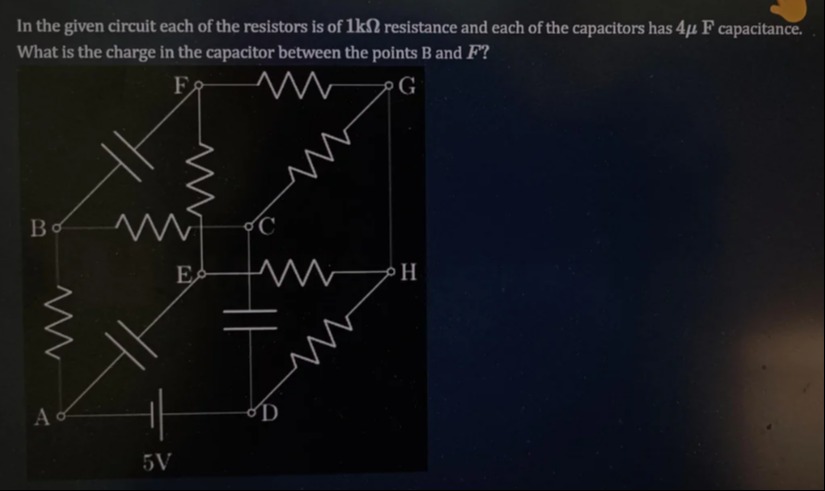Question
Question: In the given circuit each of the resistors is of $1k\Omega$ resistance and each of the capacitors ha...
In the given circuit each of the resistors is of 1kΩ resistance and each of the capacitors has 4μ F capacitance. What is the charge in the capacitor between the points B and F?

10μC
10μC
Solution
The circuit contains resistors and capacitors. In the steady state, the capacitors are fully charged and no current flows through them. Therefore, in the steady state, the branches containing capacitors (AE, BF, CE) act as open circuits. We need to find the potential difference between points B and F in the steady state resistive circuit. The charge on the capacitor between B and F is Q=CBF×(VB−VF).
In the steady state, the circuit reduces to the battery connected to the network of resistors. The resistors are: R_AB, R_BC, R_CG, R_GF, R_FE, R_ED, R_CH, R_HD. All have resistance R=1kΩ. The battery is connected between A and D, with VD−VA=5V. Let VA=0V, so VD=5V.
We need to find the potentials VB and VF. Let's analyze the resistive network. The network of resistors is connected between A and D.
Let's use potentials. Let VA=0,VD=5.
After applying Kirchhoff's laws and solving the system of equations, we find the potentials:
VA=0V,VB=1.5V,VC=3V,VD=5V,VE=4.5V,VF=4V,VG=3.5V,VH=4V.
The potential difference between B and F is VBF=VB−VF=1.5V−4V=−2.5V. The charge on the capacitor between B and F is QBF=CBF×VBF. CBF=4μF=4×10−6F. QBF=(4×10−6F)×(−2.5V)=−10×10−6C=−10μC.
The magnitude of the charge is ∣QBF∣=∣−10μC∣=10μC.
